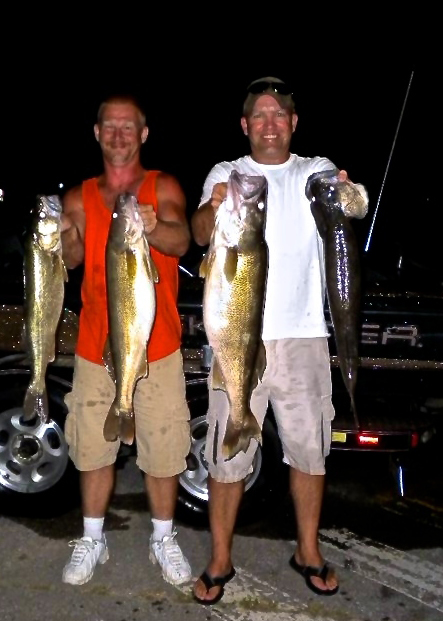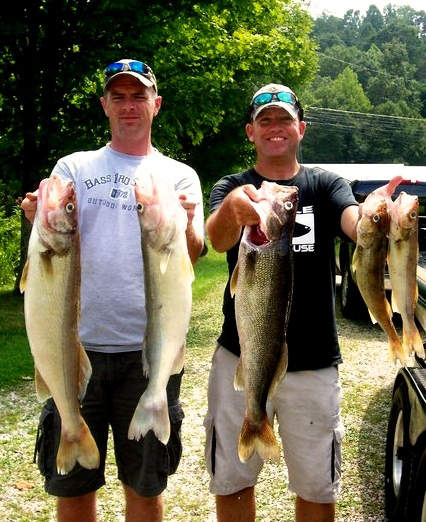BY Rich Chriscinske
I often find myself daydreaming about the summer of 2010, and for good reasons, it’s when I learned to catch trophy walleye from Paintsville Lake. I consider Paintsville to be the best walleye lake in the state and I believe it has the potential to produce the next state record. The KDFWL has been stocking the lake since ’84, and the population appears to be extremely healthy.

The walleye in this lake grow big, most likely dying of old age,without ever stretching a line. This is due to its steep rocky shorelines and acres of standing timber, which make it hard to fish. However, in the summer of 2010, I developed a summertime technique and pattern that avoids the lake’s difficult properties, and not only does it put numbers in the boat; it catches giants. So let us take a trip down memory lane and learn to catch a fish of a lifetime!
My experience with the walleye in Paintsville Lake started in late July of 2010, and happened by accident. I am an avid bass tournament fisherman, and was actually practicing for one of the many bass tournaments held on the lake, when I stumbled on this technique.
It was the Friday before a Sunday tournament in July, and I was fishing the deep milfoil and hydrilla flats with a jigging spoon. I was catching several bass and was happy to have a productive pattern. The tournament day started, and when I arrived at my first location, I noticed fish arches and bait on my Lowrance HDS unit.
Happy that the fish were still there, I lowered the jigging spoon and started the vertical jigging process, and immediately hooked up. I was excited, first cast and first bass, or so I thought. After a short battle, the fish came up and we netted her. To our surprise, it wasn’t a bass, but a four-pound walleye! Next cast, it’s another walleye! During that frustrating day, I caught three decent walleye on three casts and left the spot in search of bass. The tournament day was a bust, no bass, but the walleye were intriguing.

I wasn’t exactly sure of what I had found, but I still called my good friend. I met Kevin Frazier at the ramp in the evening, that Thursday following the tournament. We were excited, but had no idea of what was about to happen. After the short boat ride out to the deep milfoil, and a quick scan with the Lowrance depth finder, we started fishing the same spot that I fished in the tournament. On the second drop with the spoon, I felt the tell-tale thump on the fall, which is typical when spoon fishing. I set the hook, and after what seemed like several minutes, we had a beautiful 14lb. 3oz. walleye in the net. We didn’t have the fish weighed on certified scales, but did have it weighed on two different scales, and they both agreed. The fish was 31 ¼” long, with a girth of 19 ¼”, and at that time, it was considered the unofficial lake record! We caught five walleye in two hours that night, with a combined weight of 40 pounds. Wow, this was world-class walleye anywhere, and better yet; we were on some small lake in Eastern Kentucky.
Who would have thought? I grew up in Michigan, and it would be difficult to catch that kind of weight in the Detroit River during the epic spring walleye run, and nearly impossible in mid to late summer.
Being the analytical bass fisherman that I am, I spent the rest of the warm months that year and the last couple years breaking down this pattern and technique, and this is what I found:
Location
The thermocline is the most important factor. As the summer rolls on into July, the water temps soar. The thermocline starts to develop, and when it settles just below the deep weed edges, I know my work has paid off. This one feature seems to concentrate not only the bait, but the fish in predictable locations, the deep weed lines and flats. Note: I locate the thermocline using my electronics. In the summer, the thermocline shows up as a thin line on the graph above the bottom, and I sometimes have to increase the sensitivity of the unit until it’s visible. If you don’t feel comfortable or are not sure what you are seeing is the thermocline, just idle around and look for bait and fish arches. If you notice all the activity is at or above a certain depth, that depth is typically the thermocline.
The fish are located on the deep weed lines, deep weed flats, and ridges most common in the middle to lower end of the lake. Paintsville is loaded with Eurasian milfoil and hydrilla. Although I have caught fish out of both, milfoil produces best. This is due to the thickness of the weeds. The milfoil is thinner and has more irregularities, which not only makes it easier to fish; it’s what the walleye prefer.
Bait, bait, and more bait. The walleye are in these locations for one reason, bluegill. Yes, shad blown in on a windy day can make this pattern even better, but gills are the ticket. I idle a likely area and look for schools of gills with my Lowrance, and also observe the surface looking for fish feeding. When I find them, I know I am getting close to loading the boat!
When all of these components come together, I start by marking any irregularities found along the weed lines or on top of the flats. I will use down imaging and side scan and look for points, inside turns, holes, high spots, rocks, stumps, isolated weed clumps outside the main weed bed and brush piles. Typically, the fish can be found on any of these locations, but will prefer one over the others. As an example, one of my best spots on the lake is a small clearing in a deep weed flat that has a stump in the middle. The clearing is located on an inside turn in the weed line in 16’ of water, not far from the deep weed edge of 22’. The fish stack up just inside of the weeds or on the stump ambushing bait out of the clearing. It was this very spot that produced the 14lb. 3oz. giant and four more fish over 10lbs. (Note: You may or may not see the walleye on the graph, usually they are buried in the weeds. Therefore, I will fish all likely areas until I locate the fish.)
Eliminating Water
When all the homework is done, and I have located several likely spots, the technique itself is pretty simple. I position the boat just off the irregularities in the weeds and vertical jig the spoon, or make a small pitch of 5’ to 10’ fishing these sweet spots. I then rip the bait off the bottom with sharp jerks of the rod from the 3 to 12 o’clock position, letting the bait fall on slack line, while working it back to the boat. This is a pure reaction bite, so there is no need for finesse. Most of the strikes will come on the fall so I make sure to watch the line. I try covering as much water as I can, hitting all the irregularities. It is my experience that once you have found the fish on one feature, it can be duplicated on similar areas throughout the lake.


can you tell me what kind of spoons , and what weight ? carr fork lake is close by and I hear they have a great population of walleye in it . hope you can help me out, thanks
Need your help really bad, i’m disabled from accident at work several years ago and having 21bone surgeries and facing 3 more this year i need advice on how to catch a wal-eye when i can’t fish very long at a time, i would really appreciate your advice and maybe the name or names of what get to catch me one. Thank you very much.
Hello Rich
Ive been trying to get ahold of you. My son is Brian Cox he is a close friend of John Jayne who I understand you built a home for him. Im a avid fisherman. I fish the ky river below lock 6 and lock 7. And Lake cumberland I don’t fish the river in the winter because all the ramps are mudded over. I love Paintsville Lake but only get to get there about 2-3 times a year. I know Walleye will go deep during bright sunny days once the water temps reach 70. Id love for you to go fishing with me for a few hours to give me some pointers. I ll gladly pay you. My name is David Cox and im 71 years old. John Jayne calls me Papa Cox,lol. Some pretty week-end or thru the week is fine Im free anytime. Please contact me if your interested in helping an oldman enjoy his retirement,lol.
David Cox
859 469 0940
Thanks for visiting David,
For the last year I have been fighting Cancer however I am improving but I;m still not sure how much I’m going to be on the water My email is Trimmer308@gmail.com
Have a good spring
Chris Erwin
Editor
Im referring to the John Jayne that lives in Flatgap Ky